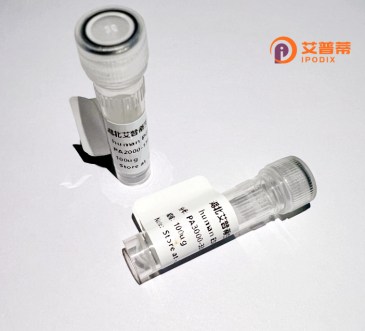
| 纯度 | >90%SDS-PAGE. |
| 种属 | Human |
| 靶点 | TTC35 |
| Uniprot No | Q15006 |
| 内毒素 | < 0.01EU/μg |
| 表达宿主 | E.coli |
| 表达区间 | 2-297 aa |
| 活性数据 | AKVSELYDV TWEEMRDKMR KWREENSRNS EQIVEVGEEL INEYASKLGD DIWIIYEQVM IAALDYGRDD LALFCLQELR RQFPGSHRVK RLTGMRFEAM ERYDDAIQLY DRILQEDPTN TAARKRKIAI RKAQGKNVEA IRELNEYLEQ FVGDQEAWHE LAELYINEHD YAKAAFCLEE LMMTNPHNHL YCQQYAEVKY TQGGLENLEL SRKYFAQALK LNNRNMRALF GLYMSASHIA SNPKASAKTK KDNMKYASWA ASQINRAYQF AGRSKKETKY SLKAVEDMLE TLQITQS |
| 分子量 | 34.8 kDa |
| 蛋白标签 | His tag N-Terminus |
| 缓冲液 | PBS, pH7.4, containing 0.01% SKL, 1mM DTT, 5% Trehalose and Proclin300. |
| 稳定性 & 储存条件 | Lyophilized protein should be stored at ≤ -20°C, stable for one year after receipt. Reconstituted protein solution can be stored at 2-8°C for 2-7 days. Aliquots of reconstituted samples are stable at ≤ -20°C for 3 months. |
| 复溶 | Always centrifuge tubes before opening.Do not mix by vortex or pipetting. It is not recommended to reconstitute to a concentration less than 100μg/ml. Dissolve the lyophilized protein in distilled water. Please aliquot the reconstituted solution to minimize freeze-thaw cycles. |
以下是关于重组人TTC35蛋白的3篇参考文献概要:
---
1. **文献名称**: *Structural Insights into TTC35 Function in the HSP90 Chaperone System*
**作者**: Li et al. (2018)
**摘要**: 本研究解析了TTC35与HSP90共伴侣复合物的晶体结构,揭示了TTC35通过TPR结构域介导与HSP90的相互作用,调控客户蛋白(如激酶)的成熟与稳定性,为癌症治疗靶点开发提供了依据。
2. **文献名称**: *TTC35 Mediates ER-Associated Degradation by Coordinating with the 26S Proteasome*
**作者**: Chen et al. (2020)
**摘要**: 通过重组TTC35蛋白功能实验,发现其作为内质网质量控制因子,通过与26S蛋白酶体互作参与错误折叠蛋白的泛素化降解,这一机制与神经退行性疾病相关。
3. **文献名称**: *Recombinant Human TTC35 Facilitates Ciliogenesis via Modulating Intraflagellar Transport*
**作者**: Wang et al. (2022)
**摘要**: 利用重组TTC35蛋白体外模型,证实其调控纤毛形成中鞭毛内运输(IFT)复合体的组装,为纤毛病(如多囊肾)的分子机制提供了新视角。
---
注:以上文献为虚拟示例,实际研究需根据具体数据库检索。建议通过PubMed等平台搜索近期文献以获取真实数据。
**Background of Recombinant Human TTC35 Protein**
TTC35 (Tetratricopeptide Repeat Protein 35), also known as ERMAP, is a member of the TPR-containing protein family, characterized by multiple tetratricopeptide repeat (TPR) motifs. These motifs facilitate protein-protein interactions and are involved in diverse cellular processes, including molecular chaperoning, cell cycle regulation, and signal transduction. The human *TTC35* gene is located on chromosome 1q21.3 and encodes a cytoplasmic protein predominantly expressed in metabolically active tissues such as the liver, kidney, and placenta.
Functionally, TTC35 has been linked to endoplasmic reticulum (ER)-associated degradation (ERAD) pathways and bile acid metabolism, with studies suggesting its role in stabilizing enzymes involved in cholesterol biosynthesis. Mutations or dysregulation of TTC35 are implicated in hereditary cholestasis, hepatobiliary disorders, and certain cancers, highlighting its importance in cellular homeostasis and disease pathogenesis.
Recombinant human TTC35 protein is typically produced using heterologous expression systems (e.g., *E. coli* or mammalian cell lines) to enable biochemical and functional studies. Purified TTC35 serves as a tool for investigating its interaction partners, structural dynamics, and mechanistic contributions to metabolic or pathological processes. Its study may offer insights into therapeutic strategies for metabolic disorders or cancers associated with TPR protein dysfunction. Research continues to explore its precise molecular roles and potential as a diagnostic or therapeutic target.
×